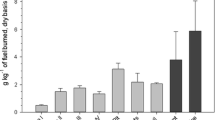Abstract
This work is devoted to a study of the combustion products of polymeric waste, expanded polystyrene, both separately and as part of mixed waste. During the experiment, samples of volatile organic components were taken. Toxic components were analyzed by gas chromatography. The data obtained indicate that the combustion of expanded polystyrene as part of discarded garbage has made a significant contribution to environmental pollution.

Similar content being viewed by others
REFERENCES
A. S. Kolosova, M. K. Sokolskaya, I. A. Vitkalova, A. S. Torlova, E. S. Pikalov, “Modern polymer composite materials and their application,” Int. J. Appl. Fund. Res., No. 5 (Part 1), 245–256 (2018).
A. S. Kolosova, M. K. Sokolskaya, I. A. Vitkalova, A. S. Torlova, E. S. Pikalov, “Fillers for modification of modern polymer composite materials,” Fund. Issled., No. 10, 459–465 (2017).
P. Araujo, C. Sayer, J. Poco, and P. Giudici, “Techniques for reducing residual monomer content in polymers: A review,” Polym. Eng. Sci. 42, 1442–1468 (2022).
“Greenpeace Report, 2020.” https://greenpeace.ru/blogs/2019/10/03/plastikovye-butylki-i-okurki-chem-zagrjazneny-berega-cennyh-prirodnyh-territorij-rossii/.
N. P. Valuev, I. Yu. Isaeva, E. A. Mashintsov, and P. M. Yudanov, “Model of a composite sorbent with increased oil capacity, based on polymer waste for oil spill response,” Izv. Tula Gos. Univ., Nauki o Zemle, No. 4, 24—32 (2019).
I. Isaeva, I. Odinokova, G. Ostaeva, and E. Eliseeva, “Composite sorbent for liquidation of oil pollution,” in Proceedings of the 7th International Scientific and Practical Conference ‘Information Technologies and Management of Transport Systems’ (ITMT) 2021”, Vol. 341.
“Reusable solutions: How governments can help stop single-use plastic pollution,” reusable_solution_ru_ web.pdf.
“A garbage dump is on fire in the Moscow region,” RIA Novosti, August 20, 2010.
Yu. V. Ryabov, Development of a Universal Methodology for Calculating the Environmental Risk of Fire at Unauthorized Dumps (St. Peterburg Nauch.-Issled. Tsentr Ekolog. Bezopasnosti Ross. Akad. Nauk, St. Petersburg, 2011), p. 3 [in Russian]
V. Gulyashchikh, “Garbage with a spark. June 17, 2013,” http://aktualno.ru (Accessed November, 12, 2013).
T. A. Aleshina, “Causes of fire at waste dumps,” Vestn. Mosk. Gos. Stroit. Univ., No. 1, 119—124 (2014).
V. V. Makarchuk et al., “Landfills of municipal solid waste—a source of bacteriological and chemical pollution of the environment,” in Proceedings of the 1st International Conference “Cooperation to Solve the Waste Problem”, Khar’kiv, 2004.
K. Pielichowski and S. Micholowski, “Nanostructured Flame Retardants: Performance, Toxicity, and Environmental Impact,” in Polymer Nancomposites and Other Materials Containing Nanoparticles (2014), pp. 251–277.
A. A. Lavrentyev, “Atmospheric pollution in the area of landfills for waste processing,” Vestn. Mosk. Gos. Agroinzh. Univ., No. 1, 84–85 (2008).
B. I. Lirova and E. V. Rusinova, Analysis of Polymer Composite Materials. Tutorial (Ural Univ., Yekaterinburg, 2008) [in Russian].
PNDF 12.1.1–99 (Federal environmental regulatory documents). Guidelines for sampling in determining the concentrations of harmful substances (gases and vapors) in emissions from industrial enterprises. https://docs. cntd.ru/document/1200034731.
Funding
This work was supported by regular institutional funding, and no additional grants were obtained.
Author information
Authors and Affiliations
Corresponding author
Ethics declarations
The authors of this work declare that they have no conflicts of interest.
Additional information
Translated by M. Drozdova
Rights and permissions
About this article
Cite this article
Isaeva, I.Y., Odinokova, I.V., Ostaeva, G.Y. et al. Combustion Products of Polymer Waste as a Source of Environmental Pollution. Polym. Sci. Ser. D 16, 627–630 (2023). https://doi.org/10.1134/S1995421223030127
Received:
Revised:
Accepted:
Published:
Issue Date:
DOI: https://doi.org/10.1134/S1995421223030127




